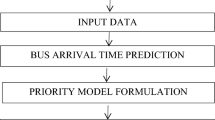Abstract
When a bus breaks down on a scheduled trip, one or more vehicles need to be rescheduled to serve that trip and other scheduled trips. A bus breakdown certainly delays the trip being served by the disabled bus and possibly delays or cancels other trips. The vehicle rescheduling problem (VRSP) is to reassign and reschedule the bus fleet to minimize the sum of operating costs, delay costs, schedule disruption costs, and trip cancellation costs. Bus operations may also be improved by bus signal priority (BSP), which can reduce bus delays at signalized intersections. If BSP is provided to the backup bus that travels to service the disabled bus’ passengers, it may reach the breakdown point more quickly. However, other buses that also pass through the corresponding intersections may be affected by signal priority. Therefore, a tradeoff must be made so that the backup bus can travel faster while other buses are not significantly delayed. A macroscopic model that integrates bus signal priority with bus rescheduling is proposed in this paper. Computational results show that the combination of BSP and VRSP effectively reduces the delay of the backup bus and decreases the delay costs.
Similar content being viewed by others
References
Carpaneto G, Dell’Amico M, Fischetti M, Toth P (1989) A branch and bound algorithm for the multiple depot vehicle scheduling problem. Networks 19:531–548
Dion F, Rakha H, Zhang YH (2004) Evaluation of potential transit signal priority benefits along a fixed-time signalized arterial. J Transp Eng 130:294–303
ITS America (2002) An overview of transit signal priority
Kim W, Rilett LR (2005) Improved transit signal priority system for networks with nearside bus stops. Transp Res Rec 1925:205–214
Li J-Q, Mirchandani PB, Borenstein D (2007) Vehicle rescheduling problem: model and algorithms. Networks 50:211–229
Li J-Q, Mirchandani PB, Borenstein D (2009) A vehicle rescheduling problem with real-time vehicle reassignments and trip cancellations. Transp Res, Part E Logist Trans Rev 45:419–433
Ling K, Shalaby A (2003) Automated transit headway control via adaptive signal priority. J Adv Transp 38:45–67
Mirchandani P, Knyazyan A, Head L, Wu W (2001) An approach towards the integration of bus priority, traffic adaptive signal control, and bus information/scheduling systems. In: VoßS et al. (eds) Computer-aided scheduling of public transport. Selected papers of the 8th international conference, CASPT 2000, Berlin, Germany, June 21–23, 2000. Lect notes econ math syst, vol 505. Springer, Berlin, pp 319–334
Mirchandani PB, Lucas DE (2004) Integrated transit priority and rail/emergency preemption in real-time traffic adaptive signal control. ITS J 8:101–115
Rakha H, Zhang YH (2004) Sensitivity analysis of transit signal priority impacts on operation of a signalized intersection. J Transp Eng 130:796–804
Sun Tran (2005) Sun Tran Monthly Operations Report, Tucson
Author information
Authors and Affiliations
Corresponding author
Rights and permissions
About this article
Cite this article
Mirchandani, P.B., Li, JQ. & Hickman, M. A macroscopic model for integrating bus signal priority with vehicle rescheduling. Public Transp 2, 159–172 (2010). https://doi.org/10.1007/s12469-010-0028-3
Published:
Issue Date:
DOI: https://doi.org/10.1007/s12469-010-0028-3




